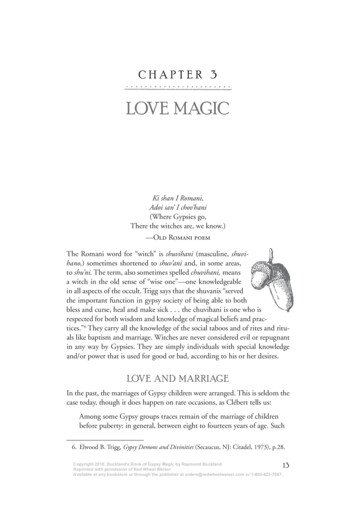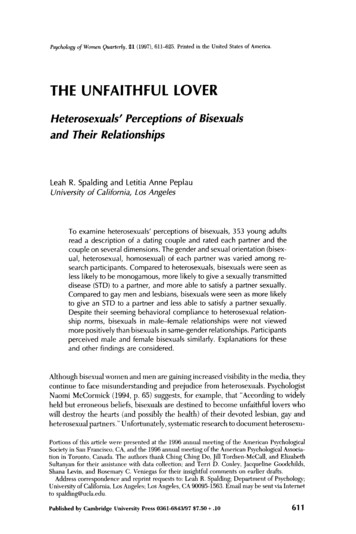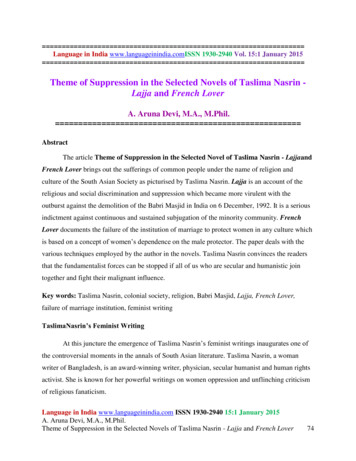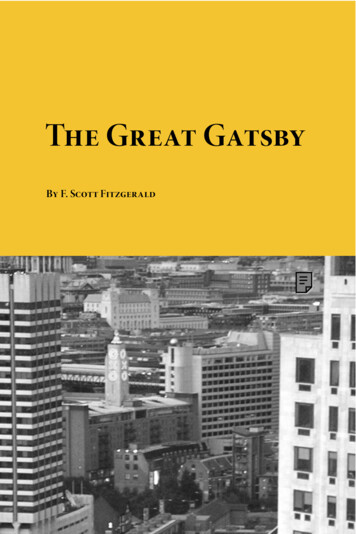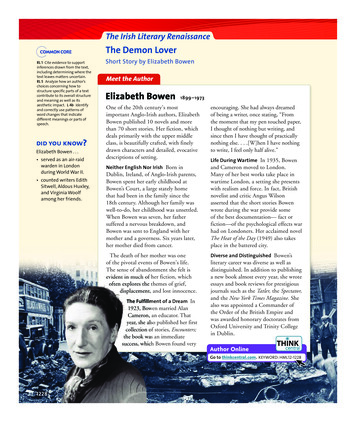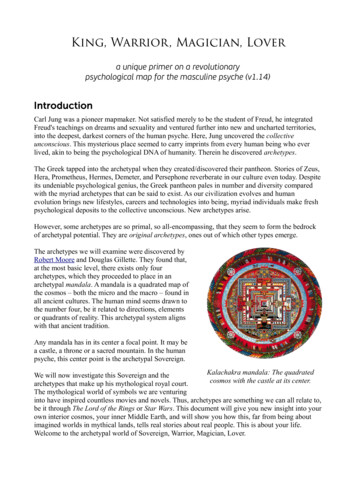
Transcription
BV 5080 .L813 1923Llull, Ramon, 12327-1316.The book of the lover andthe beloveddivisionSection
.J
THE BOOK OF THE LOVERAND THE BELOVED
/1
THE BOOK OF THE LOVERAND THE BELOVEDTRANSLATED FROM THE CATALANof ram6n LULL WITH AN INTRO DUCTORY ESSAY BYE. ALLISON PEERSLONDONSOCIETY FOR PROMOTINGCHRISTIAN KNOWLEDGENEW YORK AND TORONTO : THE MACMILLAN COMPANY1923
Digitized by the Internet Archivein 2019 with funding fromPrinceton Theological Seminary vOOIIul
MPREFACEORE than six centuries have passed since thislittle Majorcan classic was written, and, so faras I can find, it has never once been translated intoEnglish. Such an omission can only be explainedby our comparative ignorance of the treasures ofSpanish Mysticism, and perhaps in part by the fadthat Lull wrote, not in Cadilian, but in a littleknown though beautiful idiom, that of Catalonia.It would have been attradive to reproduce theoriginal version of the book together with this trans lation, and even more so to have translated thewhole of Blanquerna, of which it forms a part. Ihope that both these projeds may be realised in thefuture, together with the translations of (at lead) ElsCent Noms de Deu, El Desconort, and some of theshort hymns and poems. But it seemed bed tobegin by making known some of Lull’s bed work toas wide a circle of readers as possible. Accordingly,while following, as a rule, the olded text (which is ofthe fourteenth century) I have not scrupled to addto my translation a few passages found only in theeditions of Paris (1505) and Valencia (1521), whichilluminate the author’s thought, or seem in otherways to be of real value.On the other hand, I have not allowed myself,through a desire to expound Lull’s ideas, to subditute paraphrase for faithful and exad translation.Very few liberties have been taken with the text, andvii
PREFACEVlllthese only where a slight expansion or change ofconftru&ion has served to bring out the meaning ofan otherwise quite obscure word or phrase. Essen tially, therefore, the reader has Lull’s own vivid andforceful words, with the impediment of a foreignlanguage removed.E.ALLISONPEERSThe University, Liverpool.Jan. 19, x923.i
TINTRODUCTORY ESSAYHE average man has seldom understood theMyStic. He conceives the MyStic Life, with itsceaseless spiritual activity, and its restlessness whichknows no Stay till it reaches its goal, as a life oftranquillity, if not of indolence and ease. He has noconception of what it really is, and for that, perhaps,he should not be blamed. But not content withmisinterpreting the myStic’s life, he presently be comes more daring; he asserts that mySticism isessentially 4 unpractical,5 and that one whose aim isto reach the State of Union with God muSt necessarilybe as a fool in his relations with the world. Here theaverage man is grossly, inexcusably mistaken. Hiserror has again and again been exposed, confuted,disproved by example after example to the con trary. Yet, for all that, it seems to thrive in theaverage mind.Now, if the Story of one man’s career couldsuffice to deStroy the mistaken idea that the mySticis an unpractical dreamer, that man would surely bethe Majorcan Ramon Lull, the 4 ApoStle of Africa.’Lull lived far back in the thirteenth century, not’ long after the days of St. Francis of Assisi, whosedisciple he was. He gives us, as it were, a pre vision of the splendours of that Golden Age ofMySticism which dawned for Spain three hundredyears after his birth. His myStic writings—and es pecially his BOOK OF THE LOVER AND THEIB
BOOK OF THE LOVER AND THE BELOVEDB e L o v e d—are full of the purest and noblestspirituality, compounded with the quintessence oflove. ‘ If ye will have fire,’ he cries, ‘ O ye that love,come light your lanterns at my heart.’ His famousphrase, 4 He who loves not lives not,’ sums up hisinspiration. Yet Lull was no cloistered visionary.His life is full of romance and adventure : socrowded with incident is it that many pages will notsuffice even to summarise its principal happenings.His capacities showed the rare combination ofscholar and man of affairs : he was both these, andhe was also the man of God. To the service of hisMaster, for Whom alone he lived, and for Whom hedied, Lull was able to bring the full and completetribute of an efficient and adtive body, a superbmind, and an ardent, unconquerable spirit.1Ram6n Lull was born in Palma, the capital ofMajorca, on January 25, 1235. His father had takenpart in the conquest of Majorca from the Saracenssome six years earlier, and for his services had re ceived the gift of an estate, which his son inherited.The boy was brought up as a page in the royal courtof Majorca, and, in spite of a sound religious educa tion and the interest and favour of the King, he had2
BOOK OF THE LOVER AND THE BELOVEDhardly reached years of discretion when he began tolead a careless and dissolute life. His biographerstell of how the King, to top his degrading prac tices, married him to a certain Da. Blanca Picany,but without thereby reforming him in the lea t.Lull was chiefly enamoured of a Genoese lady, sopassionately that he dared one day to ride on horse back into the Church of St. Eulalia, where she wasengaged in devotion.Eventually she herselfarrested his intrigues. Receiving from him somegallant verses on the theme of her bosom, she calledhim into her presence, and, uncovering herselfbefore him, disclosed a malignant cancer by whichher breast was slowly being consumed.This terrible shock marked the fir t Stage inLull’s conversion. He went back to the palaceanother man—as taciturn and sombre as he hadformerly been gay and jovial. The tradition maywell be true that he saw at this time a vision of theCrucified, saying,c Ramon, follow Me ’: he himselfin some lines of autobiography tells us of five suchvisions, though when they occurred is not certain.Be this as it may, he turned from his evil life andfixed his affections on God :When I was grown and knew the world and its vanities,I began to do evil and entered on sin. Forgetting thetrue God I went after carnal things. But it pleased JesusChrist in His great pity to present Himself to me five3
BOOK OF THE LOVER AND THE BELOVEDtimes as if crucified, that I might remember Him and setmy love on Him, doing what I could that He might beknown through all the world and the truth be taughtconcerning the great Trinity and the Incarnation. Andthus I was inspired and moved by so great love, that Iloved no other thing but that He should be honoured,and I began to do Him willing service.1From the firSt, as these lines significantly bearevidence, Lull’s new ideals were directed towardsspecific objects. He was set upon the conversionof the Jews and Mohammedans who figured solargely in thirteenth-century Spain. And settingaside emotional methods as resolutely as the idea—so general then—of conversion by force, he beganto ponder what he conceived to be worthy means ofcompassing his aim—a progressive and unanswerableappeal to the reason. A sermon heard on theFeaSt of St. Francis (October 4, 1266) supplied thespark which kindled Lull’s plans into action. Hesold all his land, with the exception of a portionretained for himself and his family, gave up hisposition of seneschal in the royal palace, and retiredfirSt to a Cistercian monastery and later to MountRanda, near Palma, living there a life of Study andmeditation with the object of fitting himself tobecome a missionary to the Moslems.The record of Lull’s life in Mount Randa is onenot only of prayer, faSt and vigil, ecStasy and vision,1El Desconort} ii.4
BOOK OF THE LOVER AND THE BELOVEDbut of the Study of Arabic and the elaboration of hisscheme of a book which was to illuminate and con vert the world. He believed this Art General to bediredtly inspired by the Holy Spirit. Once it wassufficiently developed he turned in his practical wayto means by which its Study could be advanced. ToKing James II of Majorca were explained thescholar’s vaSt plans for the conversion of Islam; theKing submitted them to one Bertram de Berengario,a professor of theology, and, when satisfied of theirorthodoxy, endowed a college in Miramar for thetraining in sciences and languages of thirteenFranciscan missionaries to the Saracens (1275).Thus one part of Lull’s ideals was realised.For a short time he remained at Miramar,teaching Arabic and the Art General. But beforelong we find him lecturing on the Art in Montpellier,which was part of the Majorcan kingdom. Thenhe is at Rome, where his enterprise is san&ioned bythe Pope, and a School of Oriental Languagesfounded. He spends two years le&uring in theUniversity of Paris, learning all the time as well asteaching. A college is founded in Navarre throughKing Philip of France. Lull goes farther afield—to Palestine, Egypt, Ethiopia and Morocco. In1282 we read of his being back in France again, atPerpignan. Success continues to attend him, butnot in a measure that can satisfy his ardent soul.5
BOOK OF THE LOVER AND THE BELOVEDEver burning for more triumphs, he resolves at laStto put the lukewarmness of Europe to shame, andto go himself to Africa as an ApoStle of the Faith.After some delay (the chronology of this periodis very uncertain1) he set sail from Genoa, andlanded in Tunis about 1291. Professing only adesire to learn the truth—to convert or be convertedas events might prove—he began to debate inpublic with the Moslems, following his own logicalmethod. He was only too successful. Many ofthe infidels, attraded by his reasoning, embracedChristianity ; but the monarch began to fear for histhrone, and before long Lull found himself inprison. Condemned to death for his preaching,he was reprieved by the intercession of a Saracen ofinfluence, and banished from Africa, leaving Tunisamid insults and blows, on pain of being Stoned todeath should he ever return. For a time he evadedhis enemies and remained in the country, but a yearof this life showed him its futility, and he returnedto Naples. Here he remained writing and teachingfor a time; then he went to Rome (c. 1296), attempt ing unsuccessfully to obtain sandion for newmissionary projects; again we find him in Genoa,next in Paris (1297-8), back in Majorca, once morein Genoa (1300), then on a new campaign in Cyprus1 The date of Blanquerna, and hence of our classic, isput down at 1283.6
BOOK OF THE LOVER AND THE BELOVEDand Armenia (1300-2), back via Rhodes and Malta,where he made Stays, to Genoa and Paris (1303),Palma, Barcelona, Lyon and Montpellier (1305).1Here he saw both the King and Pope Clement V.With the former he planned a crusade for the HolyLand, but the latter, much occupied in other affairs,gave him no support.Everywhere and always evangelisation filled histhoughts. No difficulty or obje 5tion, as the recordsof these years show, could curb his zeal; thethought of imprisonment or torture made nodifference to his plans, while to die a martyr’s deathwhen his work should be done was his great ambi tion. ‘ Foolish Lover,’ says an imaginary opponentto him in his little classic, ‘ why do t thou weary thebody, throw away thy wealth and leave the joys ofthis world, and go about as an outcast of the people ? ’And his reply is the simplest imaginable. ‘ Tohonour my Beloved’s Name, for He is hated anddishonoured by more men than honour and loveHim.’In 1306 Lull determined to make an attempt topreach once more in Africa. At the outset he wassuccessful, founding a school at Bona, where he1 Lull is said to have been enticed to England (in thesummer of 1305) by King Edward I, who believed himto have the secret of the Philosopher’s Stone. But thisstory has no sure foundation.7
BOOK OF THE LOVER AND THE BELOVEDfirCt went. But on proceeding to Bugia, and be ginning to preach in the market-place, he waspromptly arreCted, all but Stoned by the crowds,summarily tried, and imprisoned in a loathsomedungeon with a view to later execution. Some thing in Lull’s personality, however (or, as somesay, the pleas of certain Catalan and Genoese inhabi tants) , saved him once more; he was even allowedthe privilege of a disputation with a Mohammedanchampion, and eventually was exiled again in thesame year of his leaving Italy.The ship in which he was returning sufferedshipwreck off Pisa, where he landed and remainedfor two years. In Pisa he wrote a book incorpora ting his memorable dispute with the Saracenapologist and other experiences in Africa. But itwould seem that these experiences had beenmodifying his belief in intellectual conversion, forhe approached Pope Clement V again with proposalsfor a new crusade. Enthusiasm for crusades, however, was a thing of the pa t, and neither the Popenor Italy as a whole gave the scheme any support.So this dauntless fighter went once more toParis, which at that time was in the grip of Averroism,and hence provided a new field for missionaryeffort. Seventy-three years old as he was, LullleCtured, wrote, and taught unceasingly against theinfidel philosophy, and won for himself fresh glory,8
BOOK OF THE LOVER AND THE BELOVEDaccomplishing in Europe what only physical forcewithheld from him in Africa.King Philip, hisroyal admirer, gave him the name of dofteurillumine, by which, in one or another of its trans lations, he is Still known to-day.The Council of Vienne (1311-2) gave Lullanother of those opportunities which he was neverslow to take. The picture of the venerable mis sionary at the feet of the Head of the Church,pouring forth his impassioned pleas for those enter prises which authority so hesitated to allow, isindeed a moving one. He painted the glory ofrecovering the Holy Places, the plight of the Chris tians in Armenia, and the peril which the Greekswere in from the Turks—themes not exhaustedeven after seven hundred years. These, however,were but a . few of Lull’s representations. Thenumber of his requests which were granted wasrelatively small, but among them was a wider schemethan any yet sanctioned for a system of colleges forthe teaching of missionary languages. This earnestof the continuance of his work mu t have encouragedbeyond measure one who, in the natural course oflife, was nearing the end of his activities.Perhaps it was this, indeed, which inspired himto cross once more to Africa, to brave its terrors andto suffer martyrdom for the Faith at la t—as fromhis conversion he had wished—if it might be the will9
BOOK OF THE LOVER AND THE BELOVED\of God. And the will of God it proved to be. OnAugust 14, 1314, he set out from Palma for Bugia.On his arrival he began his work less openly thanbefore, and for some months contrived to preachsecretly, make conversions and confirm the faithfulof earlier days. He passed to Tunis, where he hadfurther success, but for some unknown reason wascompelled to return to Bugia. Success made himbold. Feeling perhaps that the hour of supremeeffort—even if it meant the supreme sacrifice—hadcome, he threw prudence to the winds, assembled avaSt concourse, and, proclaiming himself that sameRamon who had formerly been condemned in Bugia,he preached once more the faith of the Saviour.This time the crowd broke loose, and not onlyclamoured for Lull’s death, but took him out of thecity and Stoned him (June 30, 1315), even as aJewish mob had Stoned the firSt of Christianmartyrs.Various accounts are given of his burial. Itseems that two Genoese merchants begged his bodyand carried it to Majorca, but some versions have itthat a great pyramid of light aided them in theirsearch for it, that life remained in the body until itreached Palma, and that adverse winds forced thevessel, which was making for Genoa, to land atLull’s birthplace. Flere the body was received withthe greateSI sorrow and mourning, and buried with10
BOOK OF THE LOVER AND THE BELOVEDdue solemnity in the sacriSty of the convent of St.Francis of Assisi.Ramon Lull was beatified by Pius IX. Thetitle-page of his great romance, Blanquerna, calls him4 Dodtor illuminate, Martyr unconquered of JesusChrist, Master universal in all arts and sciences.5But in his own country Lull receives the simplerhomage of a saint.iiThe foregoing sketch, for all its brevity, will haveemphasised more forcibly than much argument thepractical and the scholarly sides of Lull’s tempera ment./ We shall say nothing here of the fourhundred and eighty-six treatises 1 which he is knownto have written, nor of the thousands of other works,no longer extant if indeed they ever existed, withwhich he is credited. Nor is there need to describehis system and dodtrine, at once scholastic andpopular in charadter. The Libre de Amidi e Amat,which is here translated, is purely a myStical work,and this essay is concerned with the myStical side of1 Less than half of these works are theological. Theremainder deal with the most diverse subjects, such asmetaphysics, logic, ethics, physics, medicine, mathematics,and chemistry.II
BOOK OF THE LOVER AND THE BELOVEDLull’s mind, so wonderfully illumined by the flamewhich burnt through his long life of self-sacrifice.The Book of the Lover and the Beloved takes usfrom the African preachings and the disputations ofthe Sorbonne to those long night-watches and days ofretreat which mu t always have accompanied them,but which we are apt to forget in contemplatingthat form of a&ivity which the world counts greatest.Or the thoughts which the Book gives us may fir thave come to the young convert in the solitude ofhis monastery and the retreat of Mount Randa.Rossello, who some sixty years ago fir t publishedLull’s poems, interprets a passage from Blanquernaas autobiographical. It may well be so.Being then in his hermitage he would rise at midnight,and, opening the windows of his cell, would fall to con templating the heavens and the stars, and praying with allpossible devotion, that his soul might be fixed upon Godalone. . . . After long contemplation and much weeping,his custom was to enter the church and ring for mattins,and when his deacon appeared, to help him say them. Atdaybreak he celebrated Mass with devotion, and spoke ofGod with his deacon, that on God he might set his love.And as they talked together of God and His works, theyboth wept for the greatness of the devotion which theirargument inspired in them. Then the deacon went intothe garden and busied himself with the cultivation of thetrees in it, while Blanquerna left the church to recreatehis mind which was wearied by the work he had done,to lift his eyes to the hills, and to let them rest on theplains beneath. Feeling rested at last, he would betakehimself again to meditation and prayer, and the reading12
BOOK OF THE LOVER AND THE BELOVEDof Holy Scripture or the great book of Contemplation, andso he would be occupied until the hours of Terce, Sext andNones. . . . After this he dined . . . and went into thegarden, visited the spring, or walked in the places he lovedmost, afterwards giving himself up for a while to sleep inorder to gather strength for the labours of the night. Onawaking he said vespers with the deacon, and then re mained alone, thinking on what pleased him most andwas fittest preparation for his hours of prayer. Aftersunset, he went up to the terrace, and there remained longin devout meditation, his eyes fixed on the heavens andthe stars, discoursing with himself on the greatness ofGod and man’s inconstancies, In this state he remaineduntil he retired to rest, and such was the fervour of hiscontemplation that even upon his bed he found himself inmystic converse with the All-Powerful.Such a background as this we muSt almoSt ofnecessity assume in a life at once so adtive and sospiritual. No doubt Lull was able often to spendweeks, or at the leaSt days, in some sacred retreat,and draw from God and from Nature Strength andinspiration for his endless tasks. To these seasons ofrefreshing, it may be supposed, we owe his mySticalwritings.Of Lull’s verses many are narrative or doctrinal :the hymns entitled Hours of Our Lady St. Mary ’(.Horas de Nodr a Dona Sanda Maria), for example ;the Sin of Adam ’ (Lo Peccat de n'Adam), written at the request of the King of Majorca ’; the short Song of Ramon ’ (Lo Cant de Ramon), and aboveall the Medicine for Sin ’ (Medicina de Peccat) and13
BOOK OF THE LOVER AND THE BELOVEDthe purely didaCtic verse ‘ Application 5 of the ArtGeneral. The collection of a hundred songs on theNames of God (Els Cent Noms de Deu), on the otherhand, is more mystical than doCtrinal, and suggests,in matter as well as in title, the mystical treatise c Ofthe Names of ChriSt5 (De los Nombres de Crifto)written almost exaCtly three hundred years later bythe Salamancan friar, Luis de Leon. Mysticaltoo, as well as autobiographical, is the dialoguepoem El Desconort, ‘ made in his old age,’ thoughits spirit is that of disillusion at the refusal of thosein high places to help forward his schemes ofevangelisation. But neither of these has eitherthe Strength or the beauty of the collection of prosepoems here translated, a collection which formspart of the novel-like Blanquerna, Lull’s chief con tribution to myStical literature.His chief contribution it is, mainly, though notentirely, by virtue of the sections entitled the Artof Contemplation and our Book of the Lover and theBeloved. Blanquerna, as a whole, is a somewhatfantastic, and in places extravagant, religious ro mance—a religious Utopia, if parallels to it muStbe found, or a Catholic Pilgrim's Progress. TheStory is of a certain gallant and wealthy youth namedEvaSt, who marries a beautiful and virtuous girlcalled Aloma. They live together in great pietyand happiness, but have no children, until Aloma in14
BOOK OF THE LOVER AND THE BELOVEDher sorrow prays to God, and a boy, Blanquerna, isborn to them. The child is brought up with greatcare, and in the fear of God; and when his fathersees that he is a youth of discretion, he resolves todevote himself to the religious life. Aloma, how ever, disapproves, saying that they can both serveGod beSt in the State to which He has called them ;they decide in the end to lead lives of greaterauSterity in their home, and to give Blanquerna theoversight of the household. But, on proposing thisto the boy, they find that he has resolved to becomea hermit.Aloma is grieved, and endeavours to marryBlanquerna to a beautiful girl called Cana. Blanquerna’s reply is to persuade Cana to become a nun,while he himself retires to the desert to carry out hisresolve. The Story then describes circumstantiallyand with some prolixity the lives of EvaSt and Alomaafter Blanquerna has left them ; it passes on to Cana,who eventually becomes abbess of her convent; andfinally, after some long digressions upon convent life,to the later hiStory of Blanquerna, which occupiesthe reSt of the romance.The second book of Blanquerna deals with thehero’s life before he is ordained prieSt and rises tothe rank of abbot in the monastery which he hasentered. A digression follows, entitled * The Bookof Ave Maria,’ purporting to be an account of the15
BOOK OF THE LOVER AND THE BELOVEDdevotions to Our Lady which the hero established.The third book presents him as a bishop, and thefourth as pope.The various religious ideals presented by Lull insuccession lead up to the great ideal of his life : theevangelisation of the world. Blanquerna’s supremeaim as pope is to Strive ‘ that all infidels and schis matics may be brought into the union of the HolyCatholic Faith.’ His cardinals are quaintly namedafter the clauses of the Gloria in Excelsis Deo, andevery clause is expounded so as to illustrate theactivity which the Church should show in convertingthe heathen.To the court of the Pope comes at length ajeSter,—one Ramon the Fool,—none other, ofcourse, than Lull himself. * I would be as a fool,’he says, cto do reverence and honour to JesusChriSt, and by reason of my exceeding love I wouldknow no measure in my speech.’ Thus disguised,the author can write much which he might nototherwise have dared to put into words. And aboveall he can deliver himself of the shame he feelsbecause the Head of the Church will grant so litdeaid to those who aim at following Christ’s laStrecorded command to convert all nations.The Story ends with the decision of Blanquerna,the pope now grown old in the service of theChurch and the conversion of the heathen, to16
BOOK OF THE LOVER AND THE BELOVEDrenounce his high office, retire to a hermitage, anddevote his laSt days to contemplation and prayer.His new life is described in detail, and it is inter woven with this description that we come upon theBook of the Lover and the Beloved and the Art ofContemplation.The former is by far the simpler and moreappealing of the two, the Art of Contemplation beingconsiderably longer and full of dodtrinal teaching.It is, nevertheless, Still read, less for its didadticpassages than for its close relation with the wholeromance, its myStical aspedt, and in particular itsprayers, which are of great beauty. The Book of theLover and the Beloved is myStical throughout. Itwas written, the author himself declares, c that thehearts of men might be moved to true contrition,their eyes to abundance of tears, and their wills andunderstandings to loftier flights in the contemplationof God.’ How well it attains its objedt, and howtruly it refledts the myStic’s being, the reader muStjudge.hiWe have no wish to add to these few notes a lengthycommentary upon the substance of a book which,probably for the firSt time, is accessible to those who17c
BOOK OF THE LOVER AND THE BELOVEDread only English. Scholars have debated overLull’s probable debt to sufism, on the one hand,and, on the other, his influence upon the long lineof myStics who have followed him. There is muchStill to be said upon these and other topics, muchthat will throw fresh light on Spain and SpanishmySticism both. But in this essay enough hasbeen said of Lull’s life and works to form the in dispensable prelude to his Book. For the present,therefore, we prefer to Stand back, and allow Lull’sardent spirit to work its miracles Still. Work themit surely muSt. Writing in his native ‘ catalanprovenzal,’ that he might appeal, not to learnedmen, but to the people, by the people he is read Still.Fie needs none of the Expositions,’ such as werewritten in his own age and as late as the seventeenthcentury. Here and there a passage confuses themodern mind by its mediaeval subtleties; or thefrequent references to the will, understanding, andmemory (so common in moSt of the myStics) maypuzzle the simple reader until he has learned tointerpret them. But the vaSt majority of the threehundred and sixty-six ‘ verses,’ put together to beread one on each day of the year, may Still so be read.They speak to the twentieth century as clearly,picturesquely, and forcibly as they spoke to thethirteenth. Have we perhaps even more need oftheir message ?18
BOOK OF THE LOVER AND THE BELOVEDThey speak of elementals. Like his great suc cessors St. Teresa and St. John of the Cross, Lullknows no Master but his Beloved, Jesus Christ; hesurpasses them perhaps in this, that he is neverunmindful of the world his Beloved came to save.His is no cloistered love. He could never say, withSt. John of the Cross, 4 Live in the world as thoughthere were in it but God and thy soul.’ Ringingfor ever in his ears is the Beloved’s laSt command.Never was 4 Love’s regal dalmatic ’ worn withmore grace and fitness than by this c jeSter,’ this4 fool of love.’ It is no compliment to Lull to callhim, as the great scholar Menendez Pelayo does,a 4 Spanish Jacopone da Todi.’ Jacopone, it is true,sang of love with unsurpassable fervour :Amor, amore, tanto tu me fai,Amore, amor, che nol posso patire;Amor, amore, tanto me te dai,Amor, amore, ben credo morire;Amore, amore, tanto preso m’hai,Amor, amore, famme ’n te transire;Amor, dolce languire,Amor mio desioso.Amor mio delettoso,Annegame en amore.But Lull, who, like Jacopone, owed mo ft of hisfervour, under God, to St. Francis, has a note of hisown, no less deep, no less pure. His key is perhapsin that eloquent definition, which has been slightly19
BOOK OF THE LOVER AND THE BELOVEDexpanded in translation that the full force of everyphrase may be felt:‘ What meanest thou by love ? * said the Beloved. Andthe Lover answered : ‘ It is to bear on one’s heart thesacred marks and the sweet words of the Beloved. It isto long for Him with desire and with tears. It is bold ness. It is fervour. It is fear. It is the desire for theBeloved above all things. It is that which causes theLover to grow faint when he hears the Beloved’s praises.It is that in which I die daily, and in which is all my will.’Lull might well have written, as did a late Franciscan,John of the Angels, of the * Triumphs of the Love ofGod.’Love impels him to tread the Mystic Way * insearch of his Beloved.’ Much of his Book, there fore, deals with the MyStic Life. But it has noneof the exclusiveness of the Living Flame of Love andthe Spiritual Canticle. There are passages for thebeginner as well as for the proficient, parables inthree lines for the plain man, sermons in phrases,refledtions which, by their very simplicity, kindle thedevotion of the wayfaring man as he reads them.As we read the brief records of imaginary conversa tions between the Lover and ‘ those who asked himconcerning his Beloved,5 we can imagine ourselvesin some African coaSt-town where the Stranger whohas juSt landed is being pressed, by the surgingcrowd which surrounds him, to give reasons for his20
BOOK OF THE LOVER AND THE BELOVEDfaith. The calm and confident answers supply thesecret of Lull’s power.Then we come upon some quaintly-worded,paradoxical phrase which only refle&ion willillumine and meditation make real. And we knowthat we are following in the path of Lull when hecomposed his treatise. For it was the fruit, not ofsubtleties, but of silence. ‘ He would engage
BOOK OF THE LOVER AND THE BELOVED . B e L . o v . e d —are full of the purest and noblest spirituality, compounded with the quintessence of love. ' If ye will have fire,' he cries, ' O ye that love, come light your lanterns at my heart.' His famous phrase, 4 He who loves not lives not,' sums up his inspiration.


